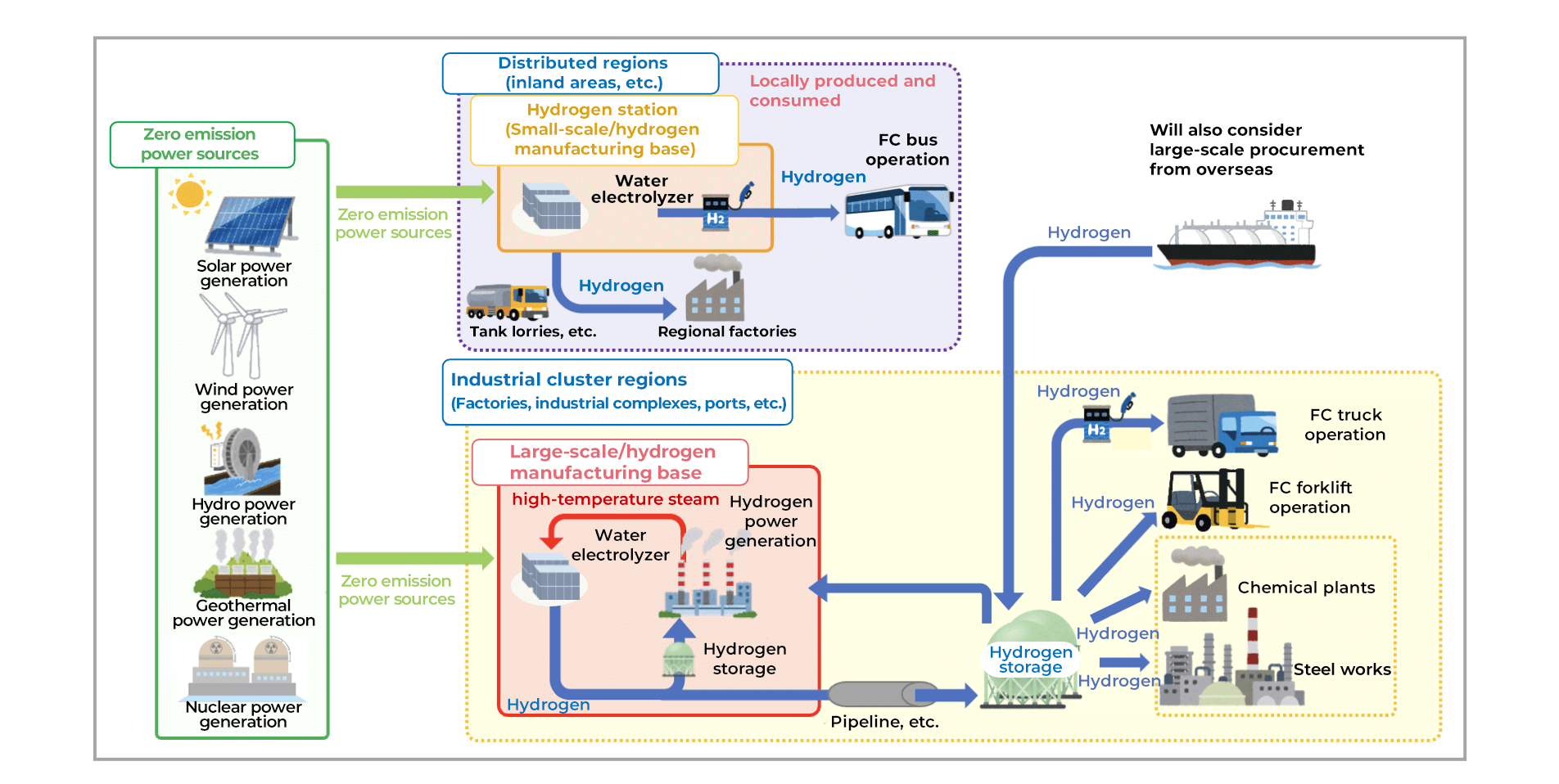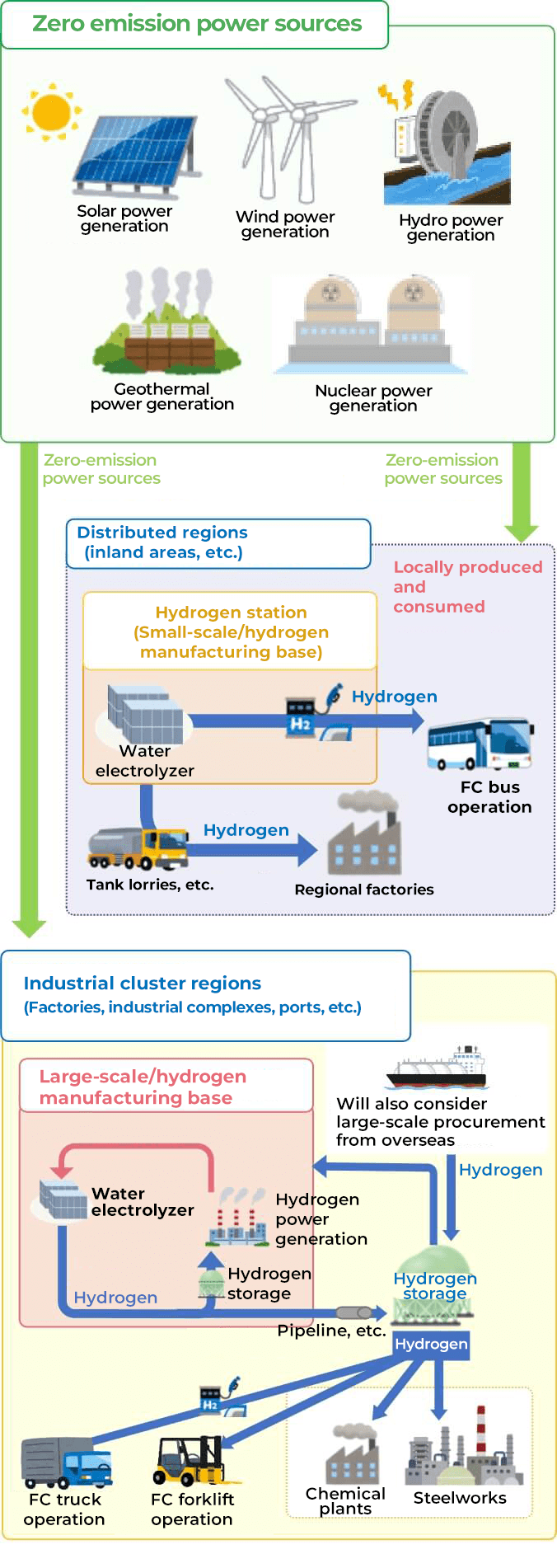Carbon Neutral Vision 2050
Carbon reduction/decarbonization in power sources (supply side)
A stable supply of net-zero emission electricity by expanding the ratio of zero-carbon energy sources
We are leading domestic firms with a roughly 60% zero-emission/FIT energy source ratio* (FY2019), by expanding the introduction of renewables and safe, stable nuclear power generation.
Total investment made over the past five years (FY2016-2020): Approximately ¥800 billion
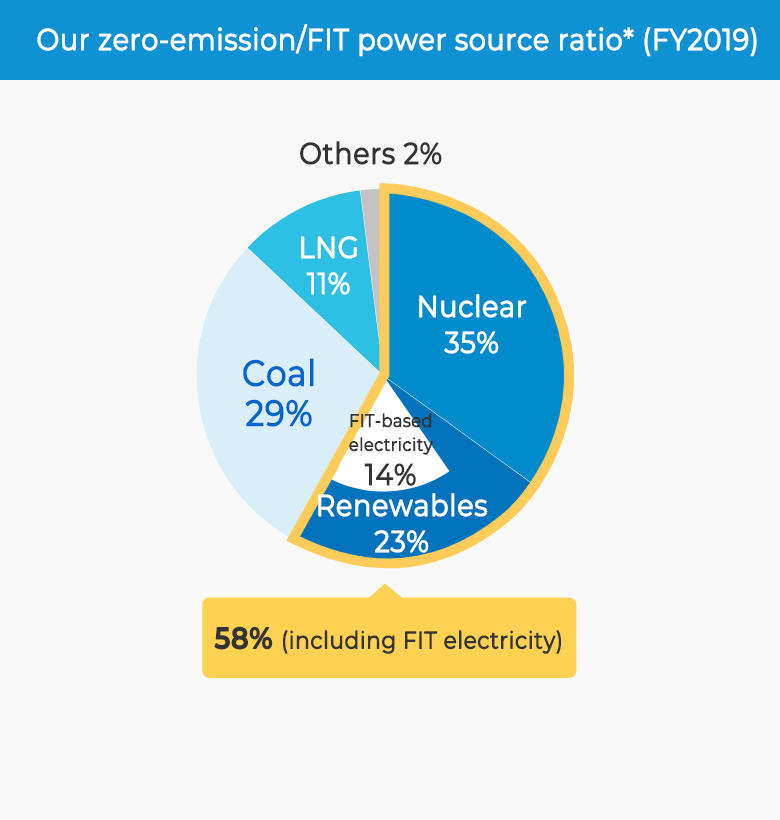

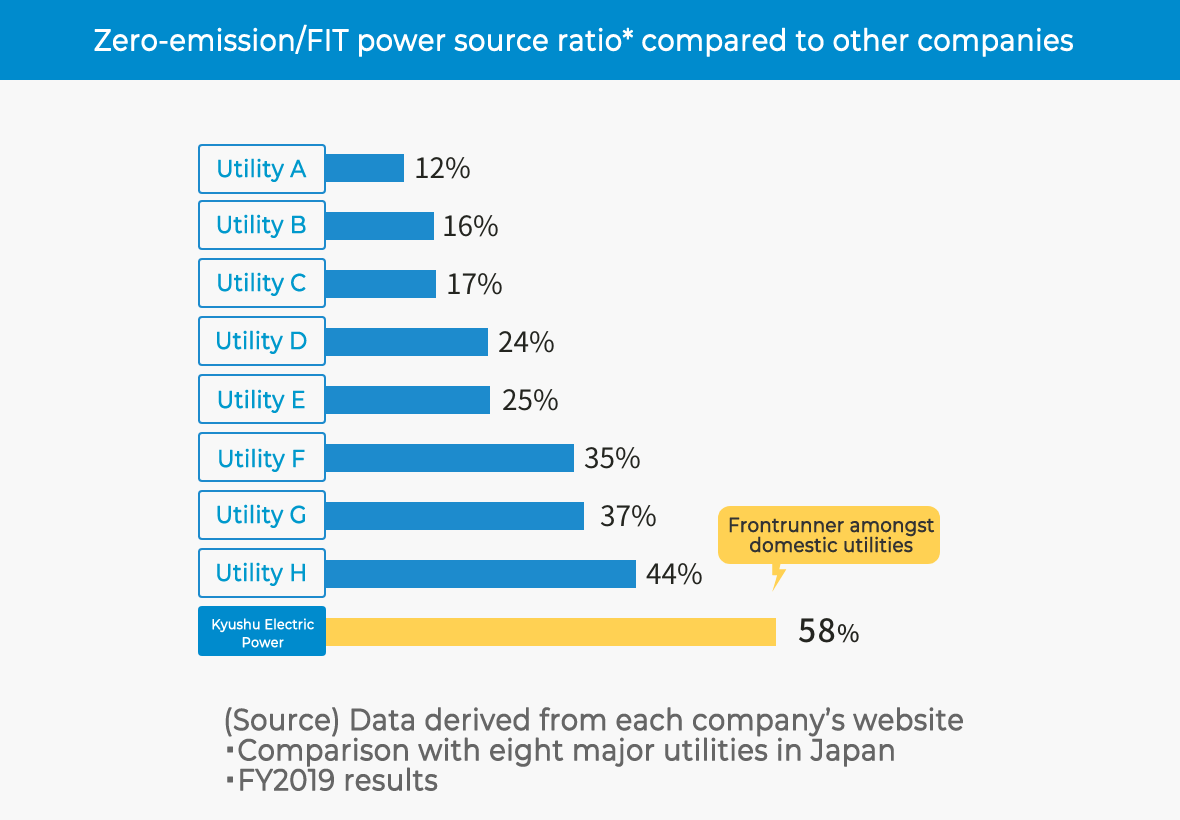
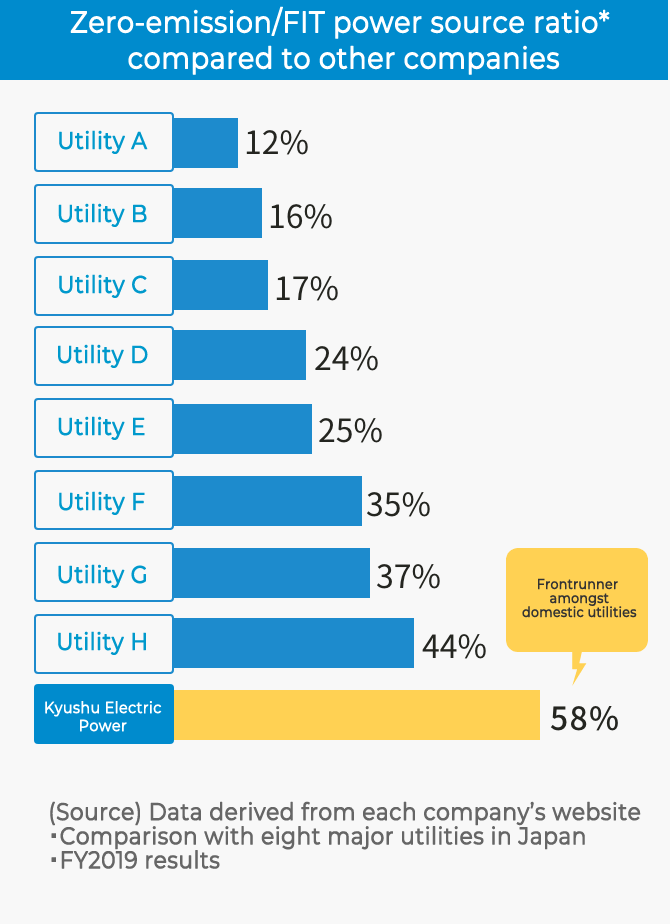
* If a non-fossil fuel certificate is unavailable, FIT power is considered neither as renewable energy nor as a source of zero carbon-emission energy but is treated as a form of electricity that emits Japan's national average level of carbon emissions, consisting of thermal and other energy sources.
Some 8% of the non-fossil value based on FIT energy sources (numbers in the achievement plan for the Act on Sophisticated Methods of Energy Supply Structures) are attributed to us. The calculation is based on the quantity of electricity we generated and procured from other companies (outlying islands are excluded).
We will aim to further decarbonize energy sources by expanding the ratio of zero-carbon energy sources.
Total investment for the coming five years (FY2021-2025): approximately ¥500 billion
Primary efforts
-
- Making renewables a main energy source and as a Group promote the development of renewables
- In dialogue with local communities and prioritizing safety, we will make maximize the use of nuclear power
- Achieving net-zero emissions in thermal power by further streamlining thermal power generation and adopting new technologies (e.g., hydrogen, ammonia)
Example of decarbonization/ lowering of the carbon intensity of energy sources

Making renewable energy our main power source (renewable energy + power storage)
- In addition to geothermal and hydropower developments, which are Kyuden Group's strengths, we will promote the development of biomass energy and offshore wind farms due to their significant introduction potential.
[Renewable energy developments in and outside Japan: 4 million kW by 2025 and 5 million kW by 2030] - We will adopt flexible administration of thermal power plants and store power at pumped storage power plants to contribute to receiving renewable energies to the maximum extent.
- We will establish integrated management technology for distribute energy resources such as post-FIT power sources (that have their FIT arrangement expired), storage batteries, electric vehicles, etc. to deploy aggregation business.
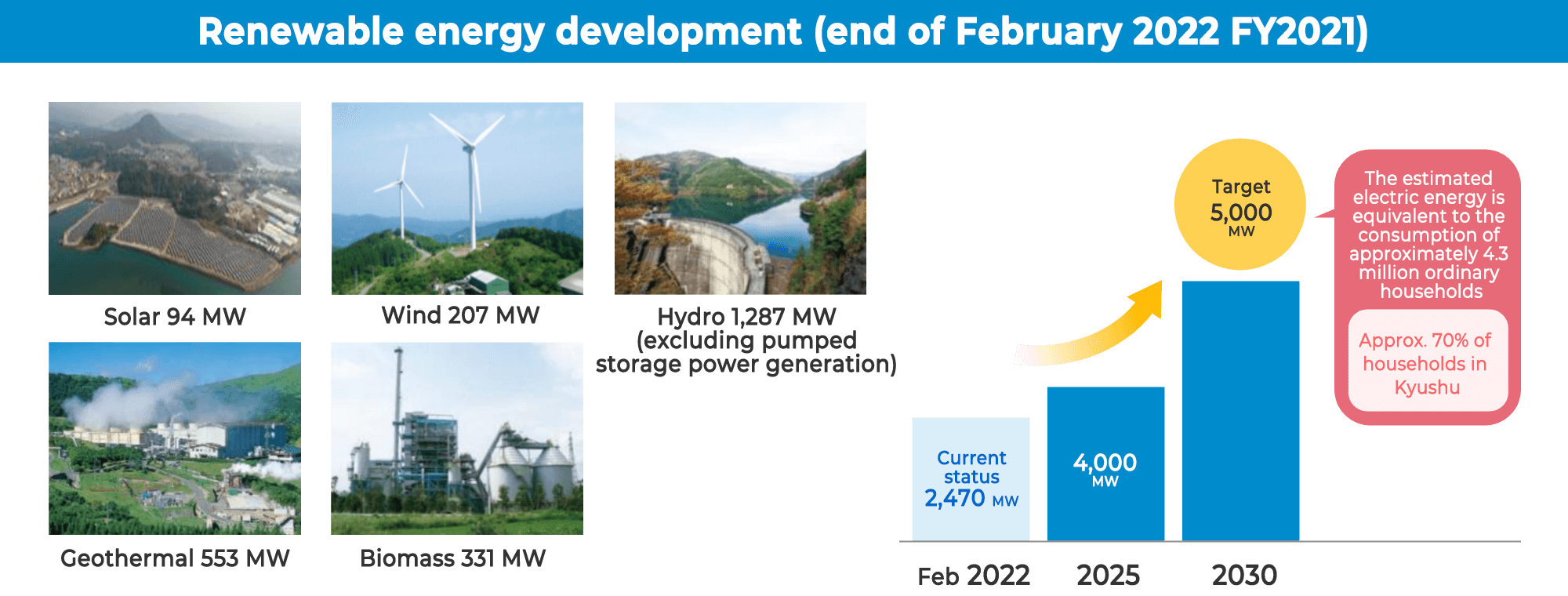
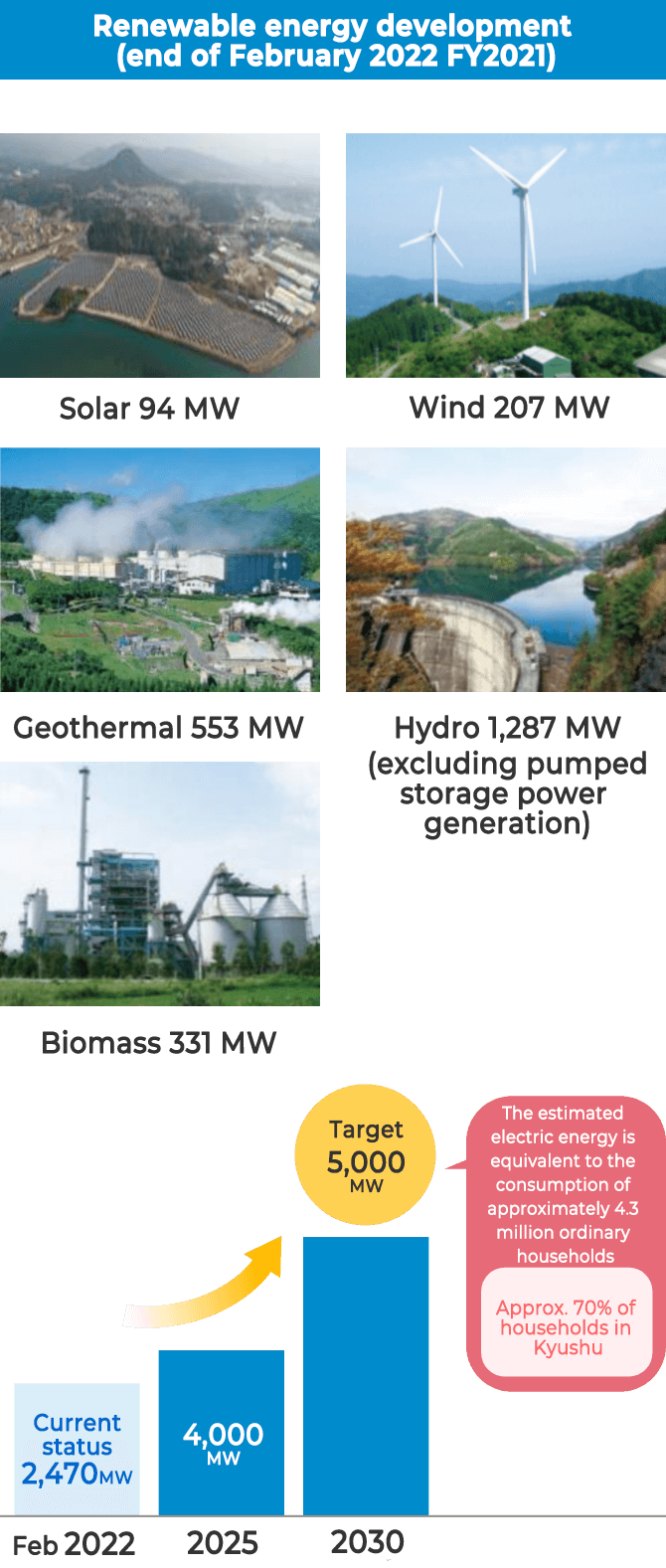
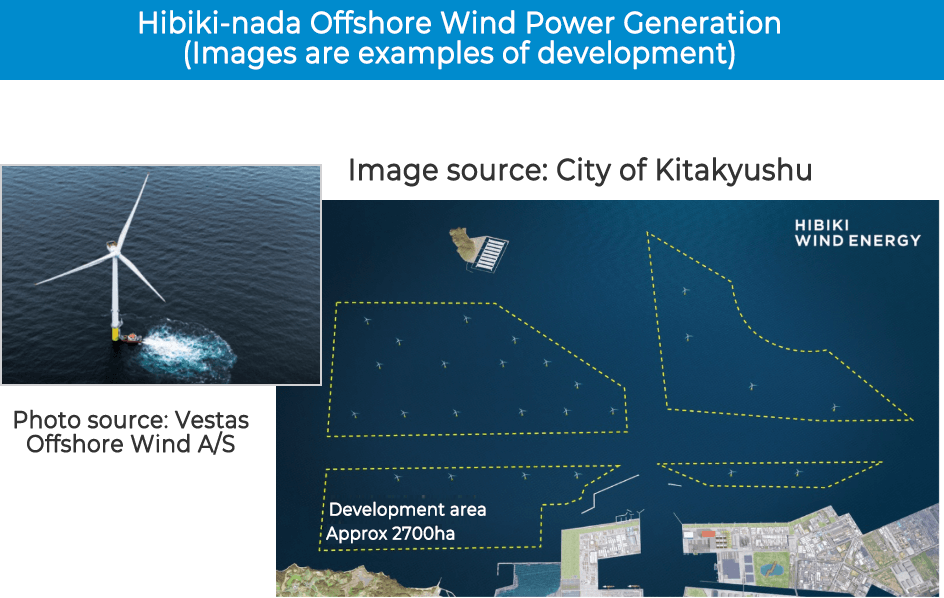
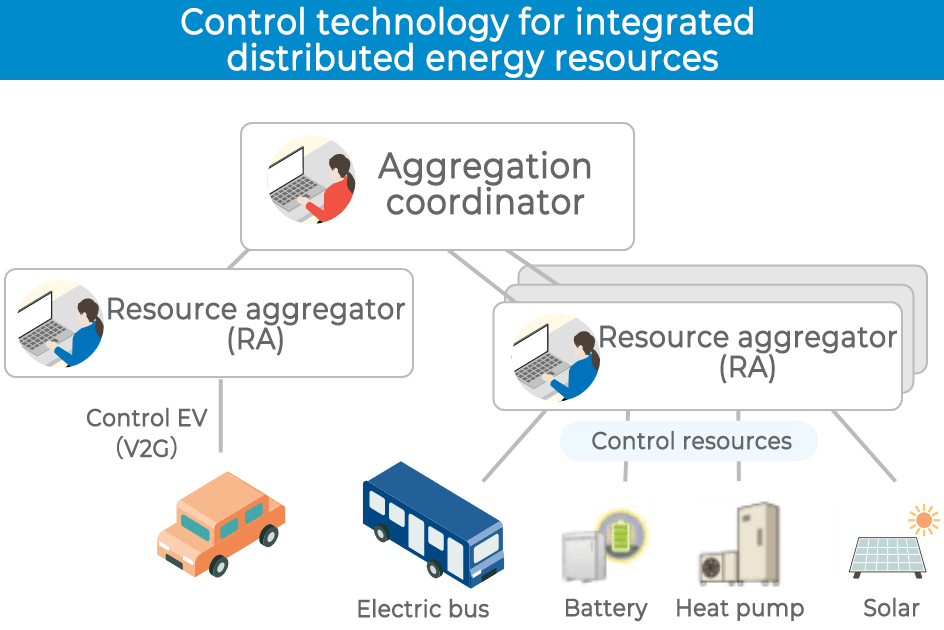
Renewables as primary power sources
- 2030 KPI
- Renewable energy development: 5 million kW (in and outside Japan)
- The Kyuden Group is proactively developing renewable energies that do not emit CO2, and aims to reach 5 million kW in renewable energy development by 2030.
- In addition to geothermal and hydropower developments, which are Kyuden Group's strengths, we will expand the development of biomass energy and offshore wind farms, which offer significant introduction potential, to promote renewables as primary power sources.
Topics
- In June 2021, the Kyuden Group issued the "First Kyushu Electric Green Bond" limited to funding projects with environmental benefits, such as renewable energy development, etc., with the objectives of enhancing its stakeholders' understanding of its efforts towards "decarbonizing / lowering the carbon intensity of electricity sources" and diversifying its financing.
Overview of the First Kyushu Electric Green Bond

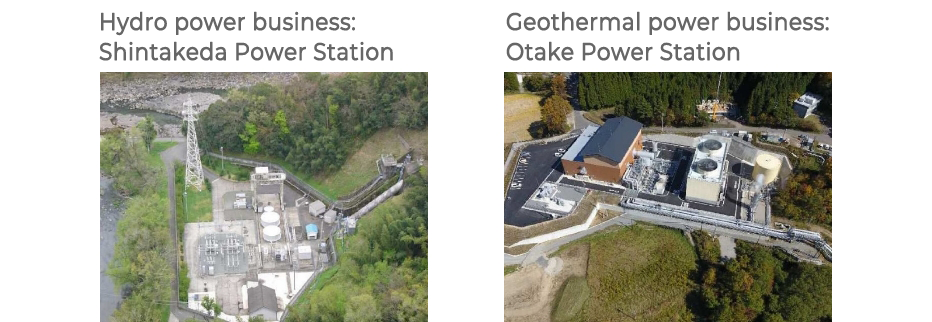
Hydro power business: Shintakeda Power Station
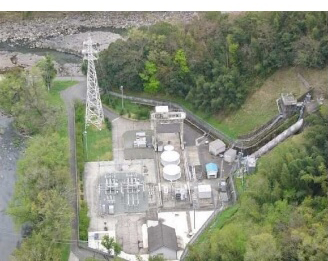
Geothermal power business:Otake Power Station
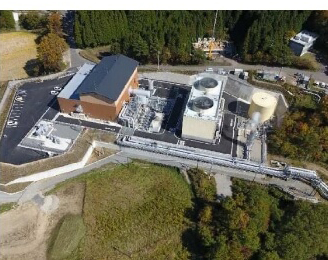
- As for solar power generation, we are working on a mega-solar power generation project using the former site of Kyushu Electric's power plants and others.
- We will also promote efforts towards the effective use of existing resources, such as the purchasing of power from post-FIT power sources that have reached the end of their purchase period under the FIT system.
Omura Mega Solar Power Station(Kyuden Mirai Energy)
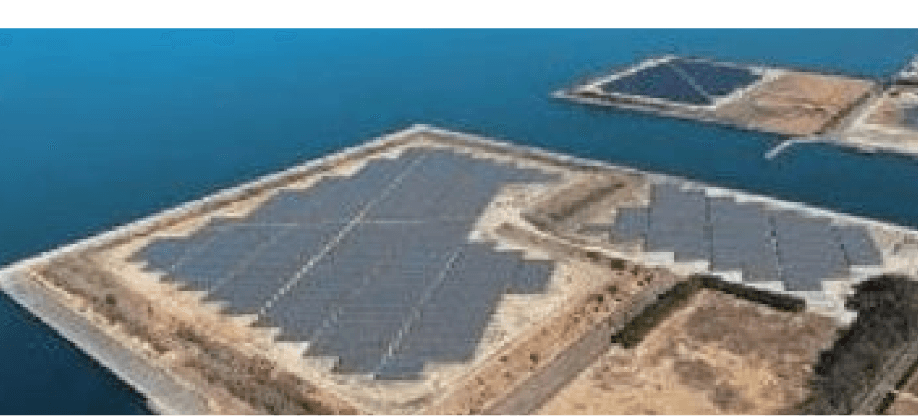
List of solar power generation facilities (end of February 2022)

- We incorporate renewable energy to the maximum extent possible through the use of pumped storage power stations and the Buzen Battery Substation, which has one of the world's largest energy storage systems, to maximize the use of renewable energy and respond appropriately to fluctuations in output to ensure a stable supply of electricity.
- Also, we will establish integrated control technologies for distributed energy resources, such as post-FIT power sources, storage battery, and electric vehicles (EV), and develop aggregation businesses.
Large-capacity storage system (Buzen Battery Substation)

Changes in the frequency of pumping (increase in daytime pumping to maximize the acceptance of renewable energy)
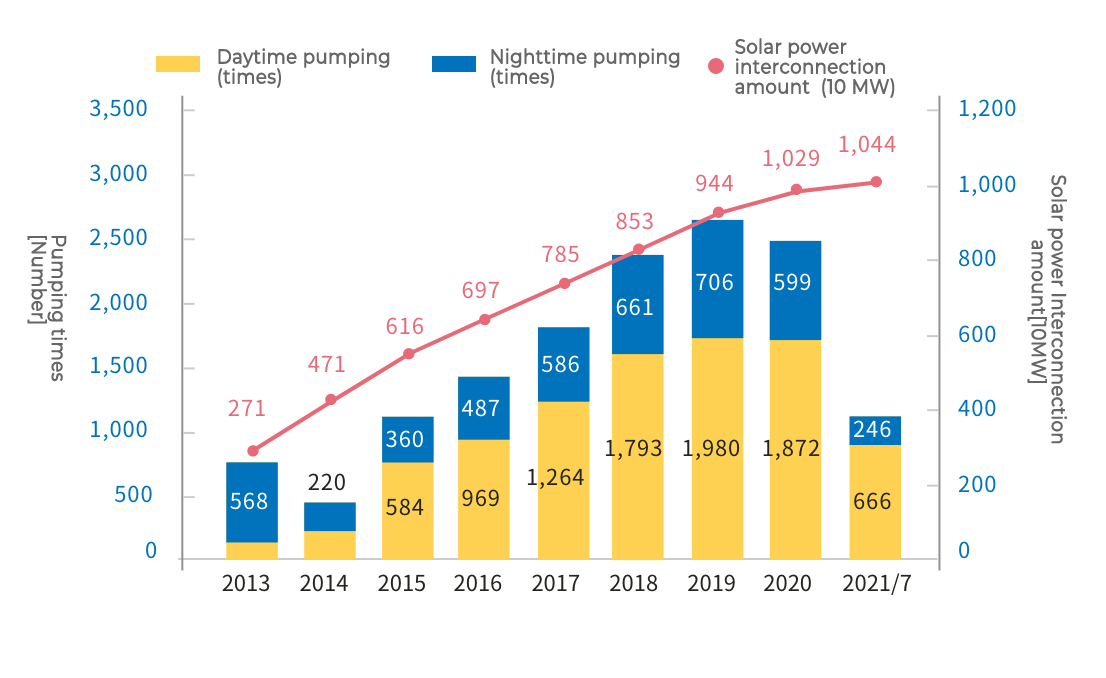
Integrated control technologies for distributed energy resources
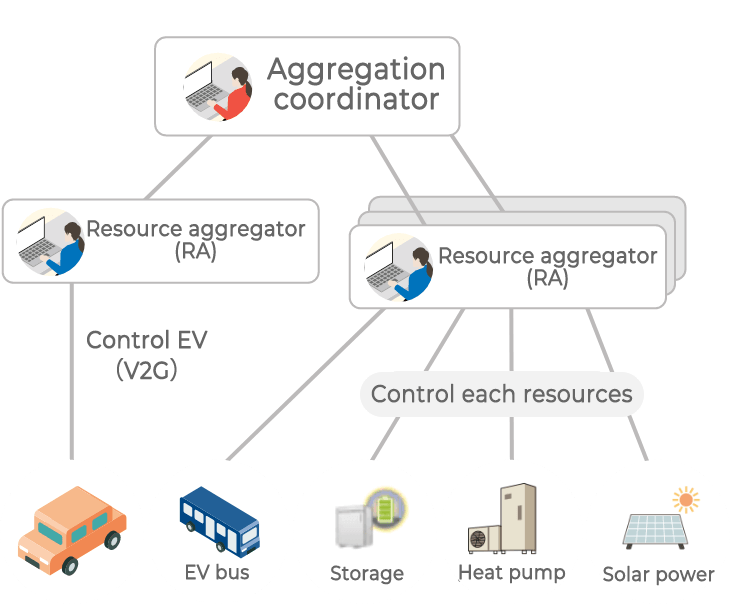
- Kyuden Mirai Energy and other companies are working on developing wind power generation in promising areas where long-term,stable and economical wind power generation is possible, in consideration of harmony with the surrounding environment.
- Since FY2017, a consortium led by Kyuden Mirai Energy has been working on realizing offshore wind power generation (maximum power output: approximately 220 MW) in Hibiki-nada, Kitakyushu City, Fukuoka Prefecture.
List of wind power generation facilities (end of February 2022)
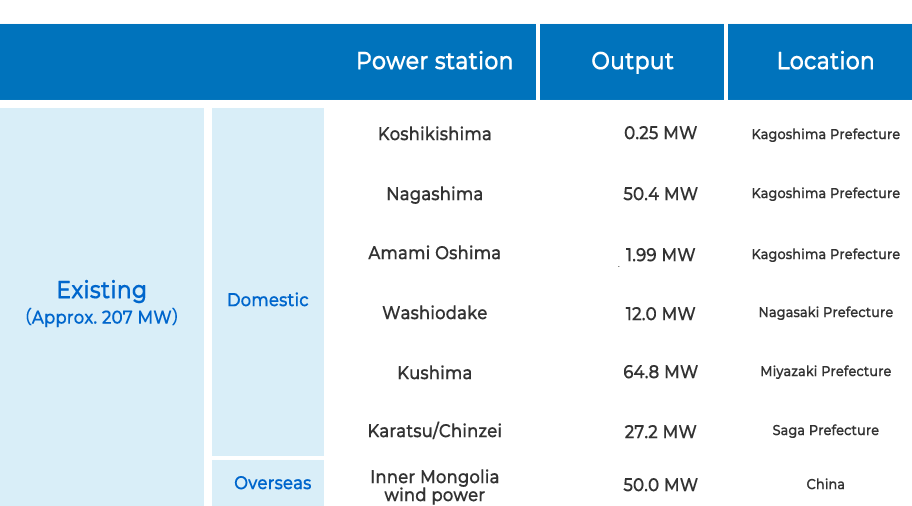
Offshore Hibiki-nada wind power generation(development image)
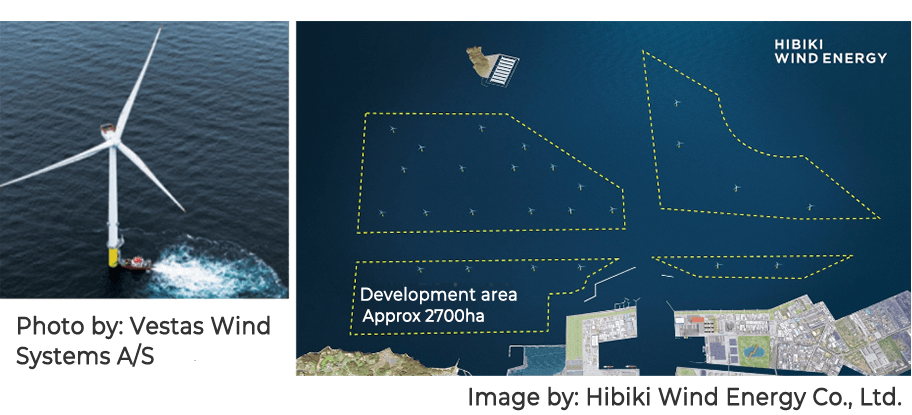
- We are working on the development of hydro power generation in harmony with the local community by comprehensively taking into account technical aspects, economic efficiency, and the location environment.
- We are promoting new development and renewal of old existing power stations using the FIT/FIP system, etc., to make effective use of unused energy.
List of hydro power generation facilities (end of February 2022)
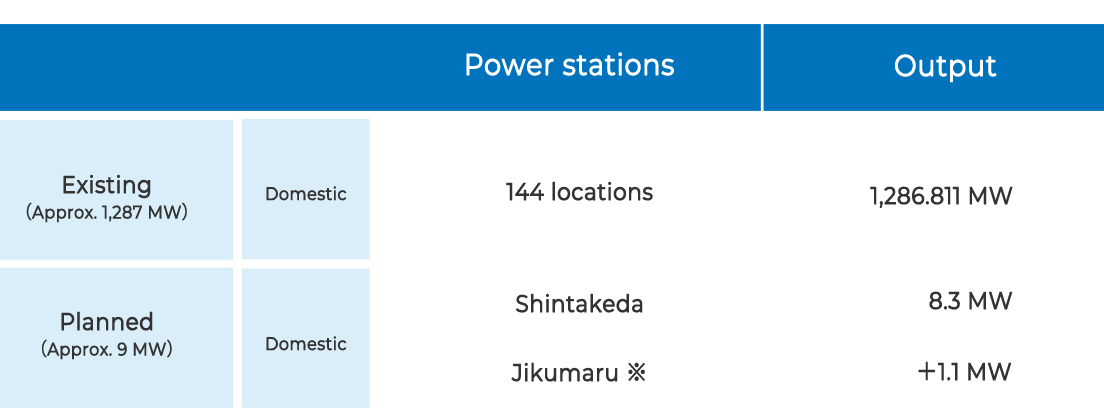

*Increase in output associated with renewal of power generation facilities
- The Kyuden Group's geothermal power generation generates approximately 220 MW in Japan, and accounts for approximately 45% of the installed capacity nationwide. Currently, geothermal power resources are being surveyed in Kyushu (5 sites) and outside Kyushu (1 site Sarukuradake, Fukushima Prefecture), and we will continue to promote development.
List of geothermal power generation facilities (end of February 2022)
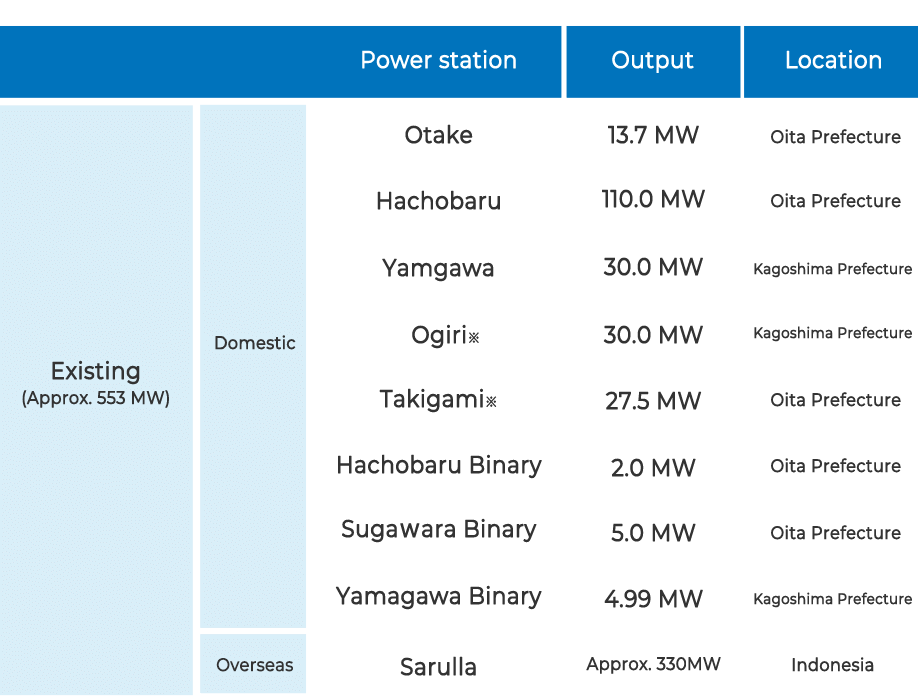
*Joint development/operation with steam supplying companies
Survey points in Kyushu (end of February 2022)
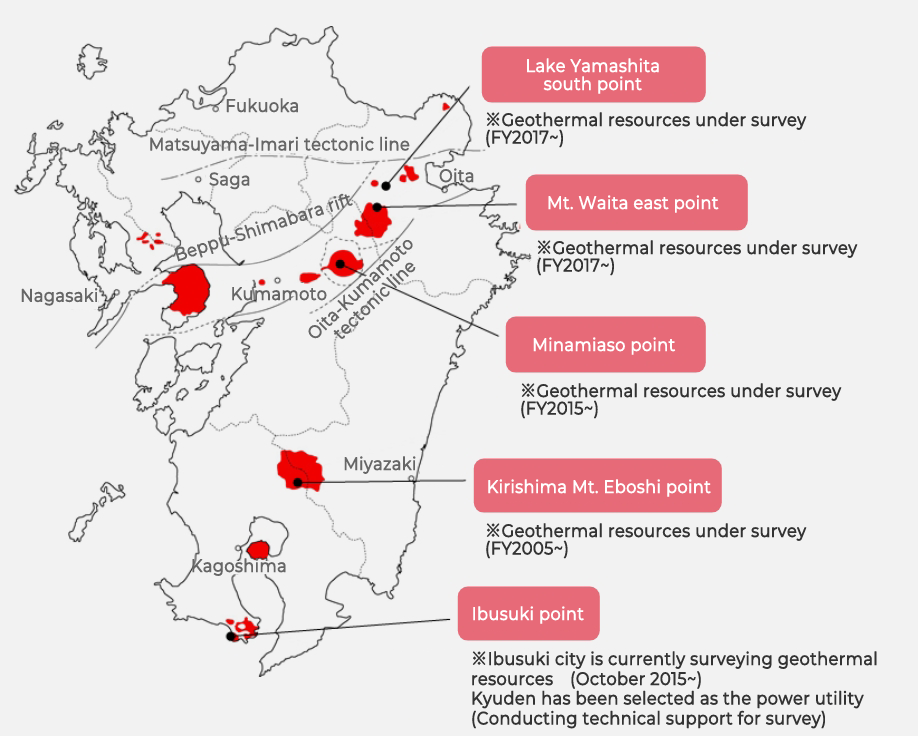
- As biomass power generation uses wood chips and pellets made of nature-derived wood as fuel, it does not affect the amount of CO2 in the atmosphere *1and the use of unused energy such as forest residues and livestock excrement is expected to contribute to local communities.
- Kyuden Mirai Energy, under the "Biomass Resource Recycling Concept (Mirai Green Ring)" for sustainable resource recycling of woody biomass, is promoting the commercialization of upstream wood pellet production and downstream effective utilization of incineration ash from biomass power plants, based on its existing power generation business.
*1 The CO2 emitted from burning biomass fuel is CO2 that was originally absorbed by plants, and so as the net amount of CO2 emitted and absorbed is zero, the total amount of CO2 does not increase; this is the concept of "carbon neutral" carbon cycling.
List of biomass power generation facilities (end of February 2022)
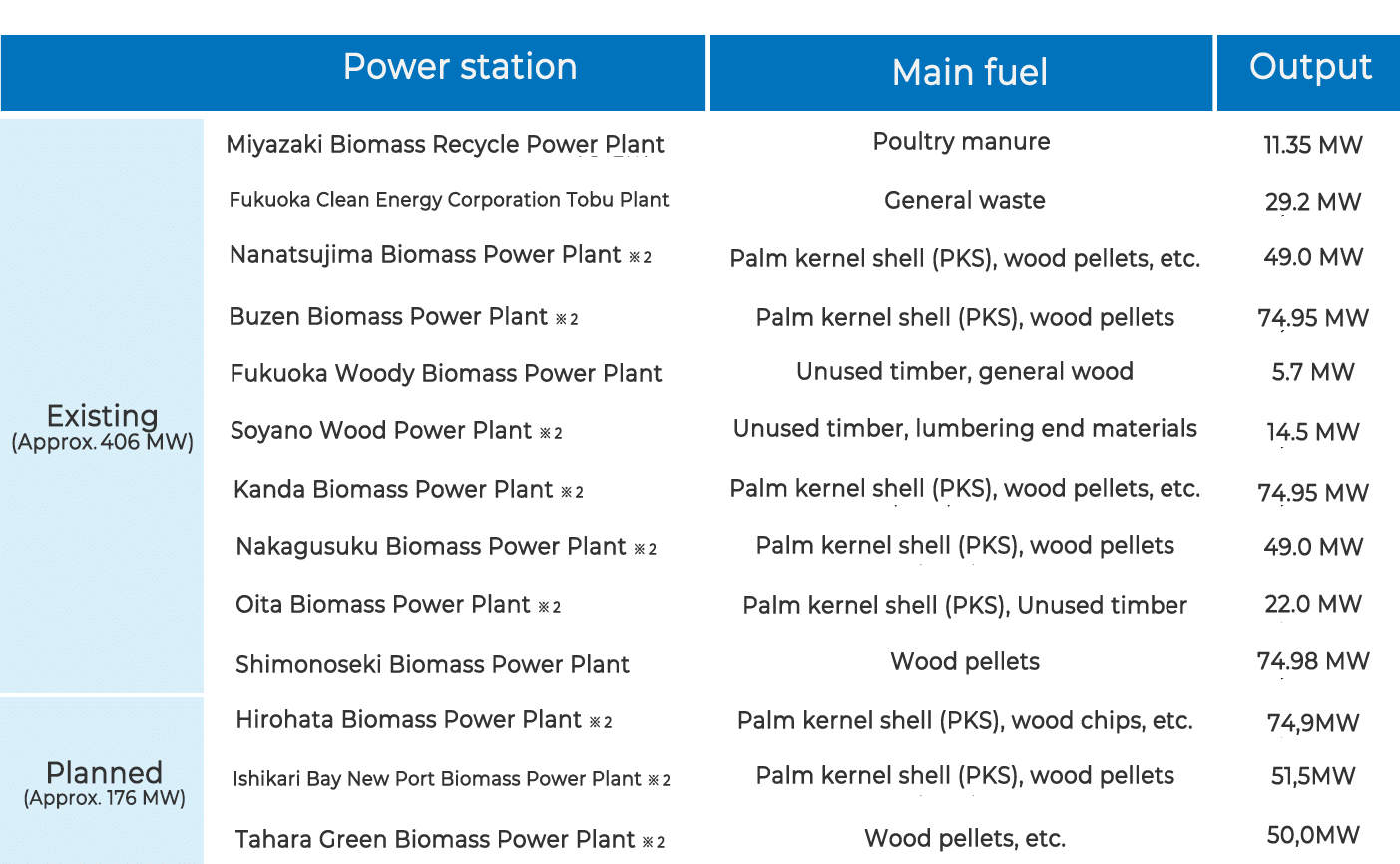

*2 Development by a SPC (Special Purpose Company) funded by the group company
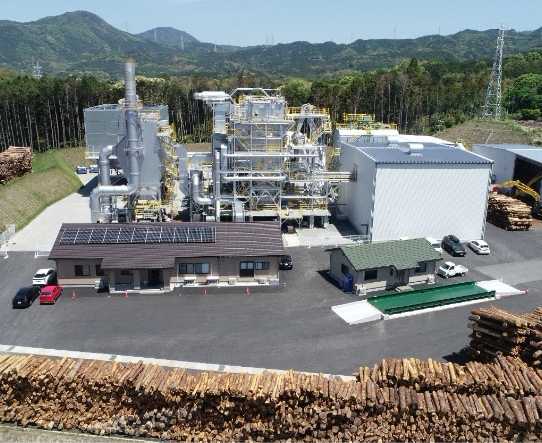
Fukuoka Woody Biomass Power Plant (Chikuzen, Fukuoka Prefecture)
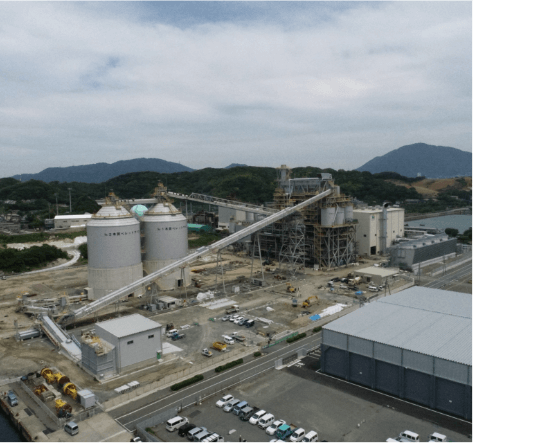
Shimonoseki Biomass Power Plant(Shimonoseki, Yamaguchi Prefecture)
Biomass resource cycle concept (Mirai Green Ring)
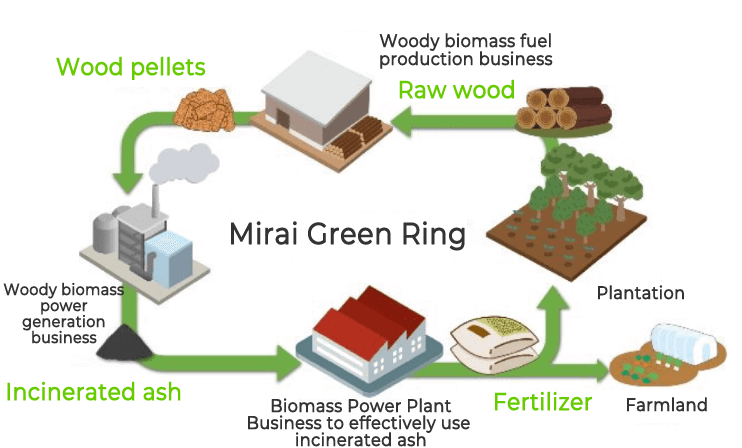
Topics
- Naruseto Strait in Goto, Nagasaki Prefecture was selected in May 2019 by the Ministry of the Environment through public offering as the location for Japan's first large-scale tidal power generation (500kW) verification test, which started in January 2021. (Scheduled for completion in March 2022)
- Tidal power generation uses tidal currents (currents of seawater generated by the ebb and flow of the tide) to turn the propeller to generate power, and there is great development potential in Western Japan.
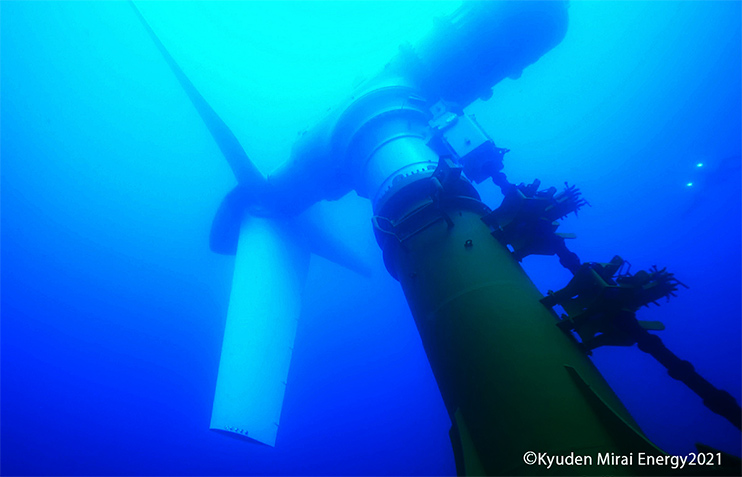
Study framework regarding tidal power generation
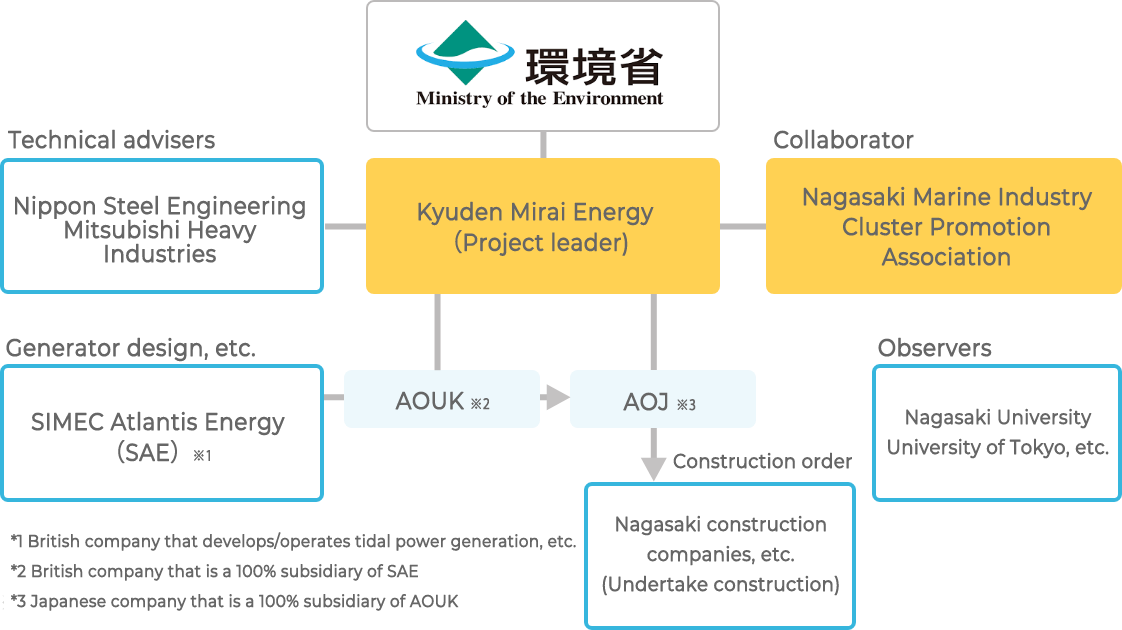
Active development of overseas business
- 2030 KPI
- Amount of renewable energy to be developed: 5,000 MW(domestic and international)
- We are developing energy-related businesses in countries around the world by utilizing the technologies and know-how related to the electric power business that the Kyuden Group has accumulated in Japan and overseas. We have positioned it as one of the highly promising growth businesses with an eye on future market expansion, and are actively promoting the expansion of deployment areas and business domains in order to achieve our overseas equity output target of 5,000 MW by 2030.
- In the area of renewable energy, we will promote the development of renewable energies to the maximum extent possible while carefully considering profitability and the regional characteristics of the country, aiming to develop 5,000 MW of renewable energies in Japan and overseas by 2030.
- In the area of thermal power generation, we will contribute to the reduction of GHG emissions by participating in the construction of state-of-the-art, high-efficiency thermal power plants to replace aging thermal power plants, while taking into consideration the energy situation in the countries concerned.
- We will also provide energy solutions that meet the needs of the region and the times such as micro-grid business mainly in island countries and consulting business based on our experience in Kyushu in dealing with the introduction of renewable energy.
Examples of specific efforts (blue boxes are consulting businesses)
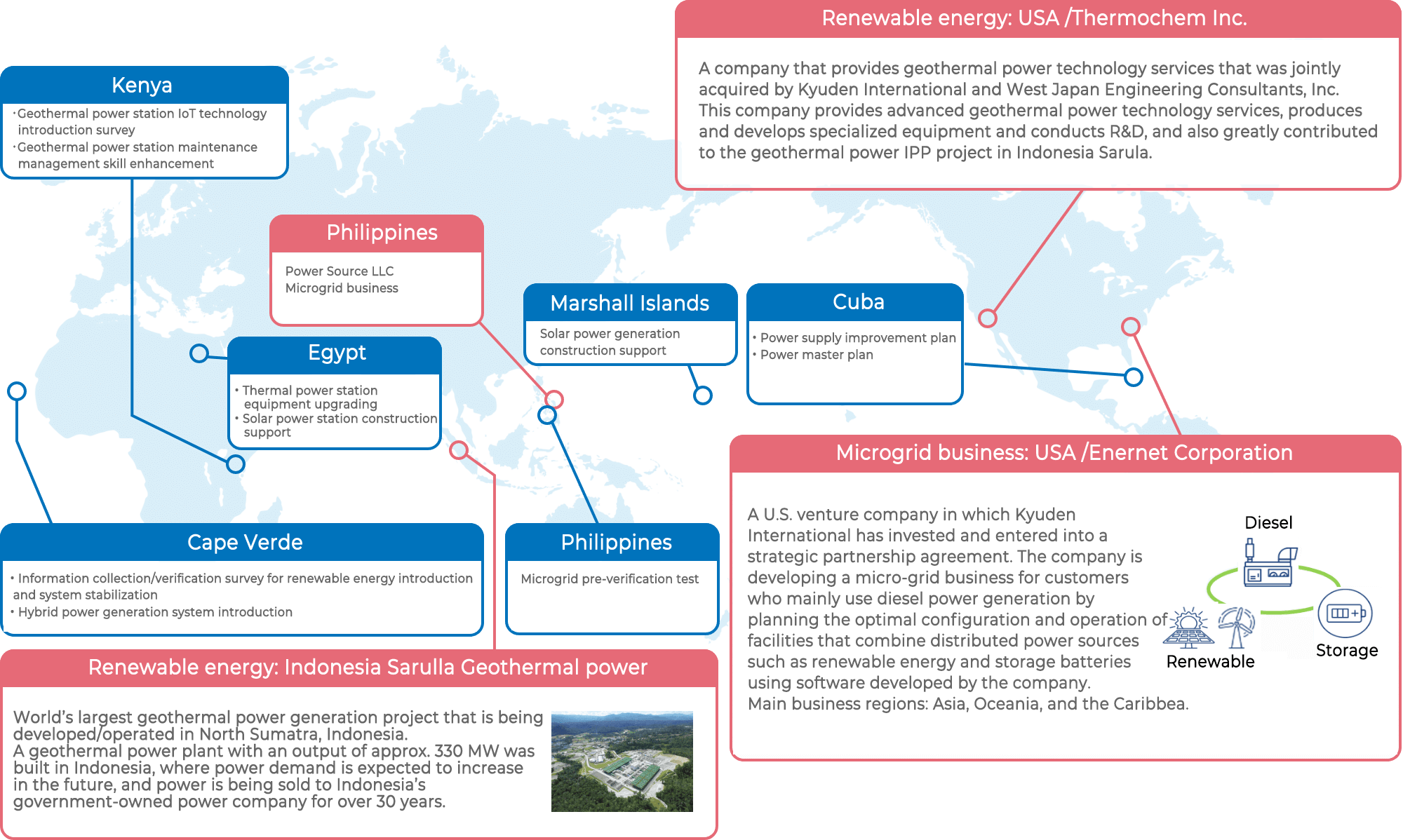

Maximizing the Use of Nuclear
- Nuclear power is a stable source of energy that features high energy density, emits no CO2 while generating electricity, and is unaffected by weather or climate*1
- In dialogue with local communities and prioritizing safety, we will maximize the use of nuclear power, by enhancing the capacity factor of existing reactors.
- We will consider using advanced reactors that offer high levels of safety, including next-generation light water reactors, SMRs*2, and HTGRs, as well as leveraging nuclear energy to produce hydrogen.
*1 The high-level radioactive waste from fuel reprocessing is planned for final storage in stable, deep undergroundstrata.
*2 Small Modular Reactors
SMRs
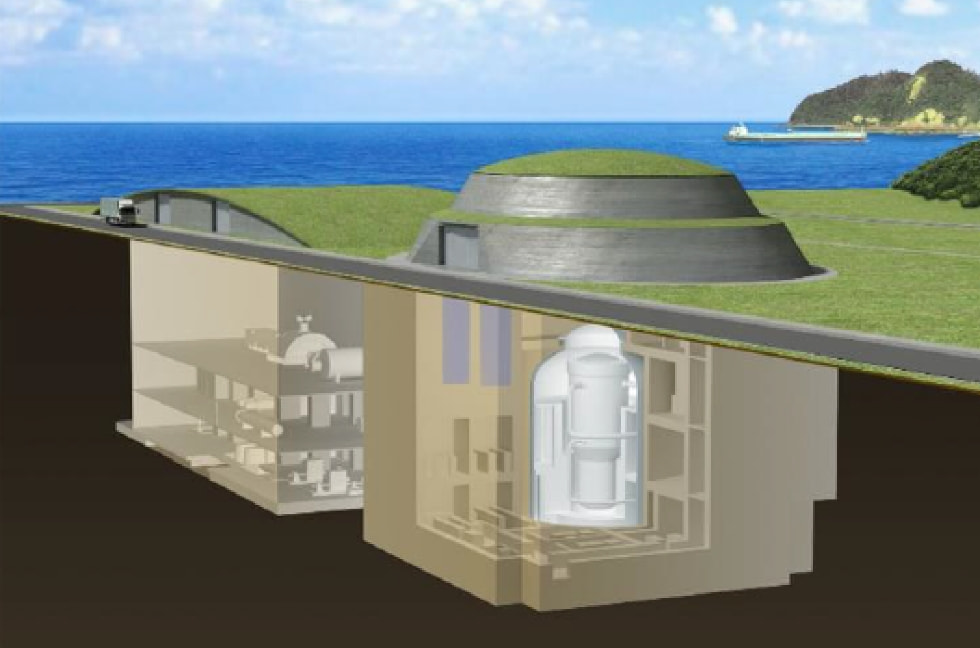
- Features passive safety system that does not require external energy sources in the event of an accident
- Features reactor with integral steam generator and natural circulation for core cooling combined
➡Theoretically, this eliminates the possibility of loss of coolant and other accidents
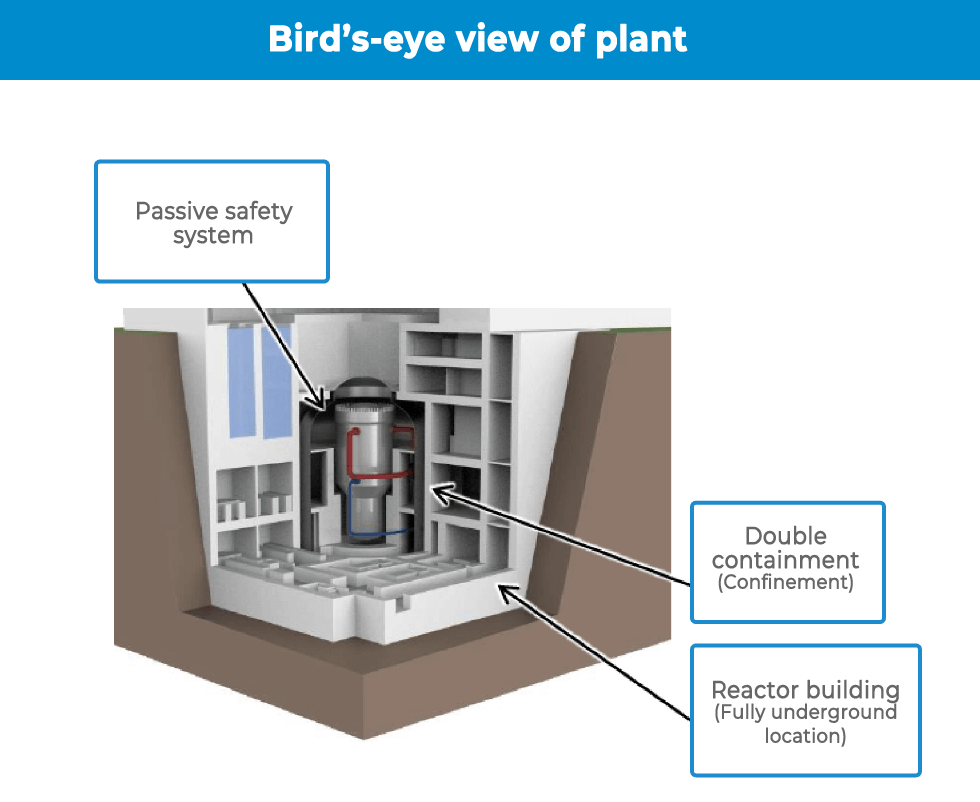
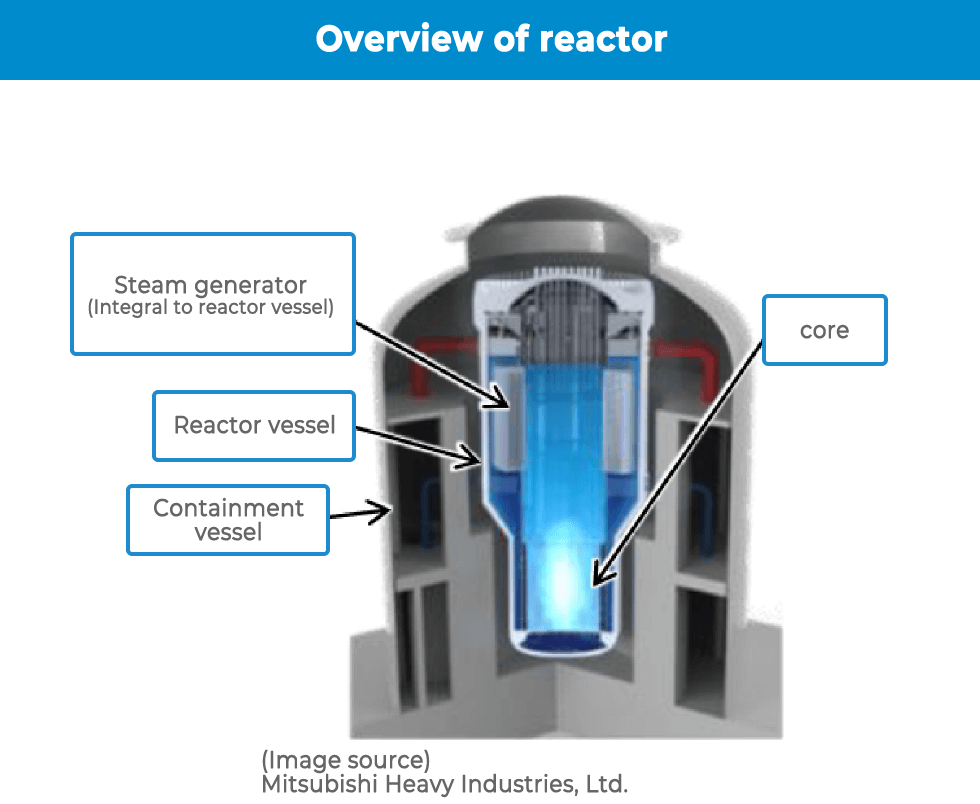
HTGRs + Hydrogen production (Example)
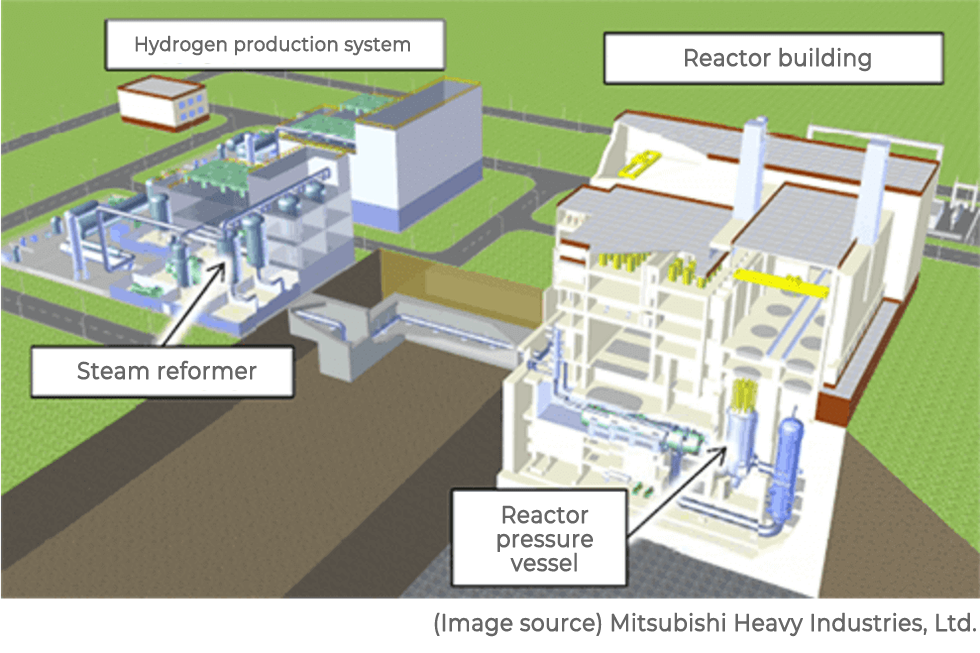
- Uses highly heat-resistant graphite core/ceramic-coated fuel,and helium gas coolant that is stable at high temperatures
➡The heat can be used in non-power generation sectors, such as hydrogen production - Can cool the core with natural circulation of outside air and heat discharge
➡Loss of coolant will not damage core
Maximum use of nuclear power
- Nuclear power is an excellent power source in terms of CO2 emission reduction and energy security, and from the perspective of securing stable power supply for a long period of time, we will make maximum use of nuclear power with safety as a top priority.
- We will continue to work on improving the safety and reliability of the nuclear power plants currently in operation, and continue their safe and stable operation to maximize their utilization. In addition, with safety as a top priority, we will begin full-scale studies at an early stage to improve the utilization rate of facilities.
List of nuclear power generation facilities (end of February 2022)
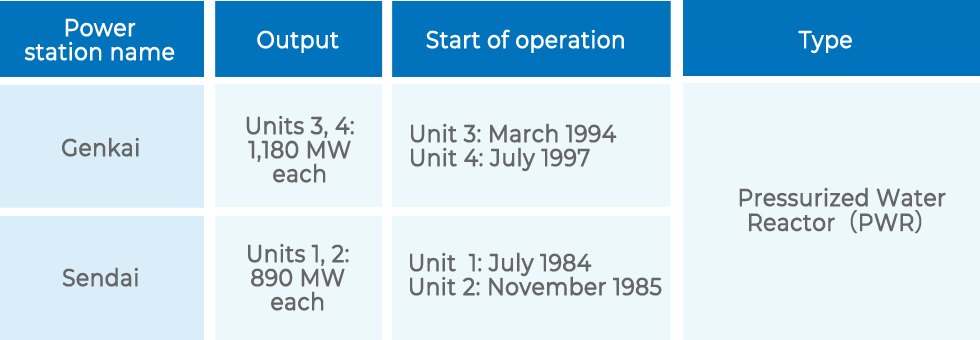
(Note) Genkai Unit 1 ended operation in April 2015, and Genkai Unit 2 ended operation in April 2019
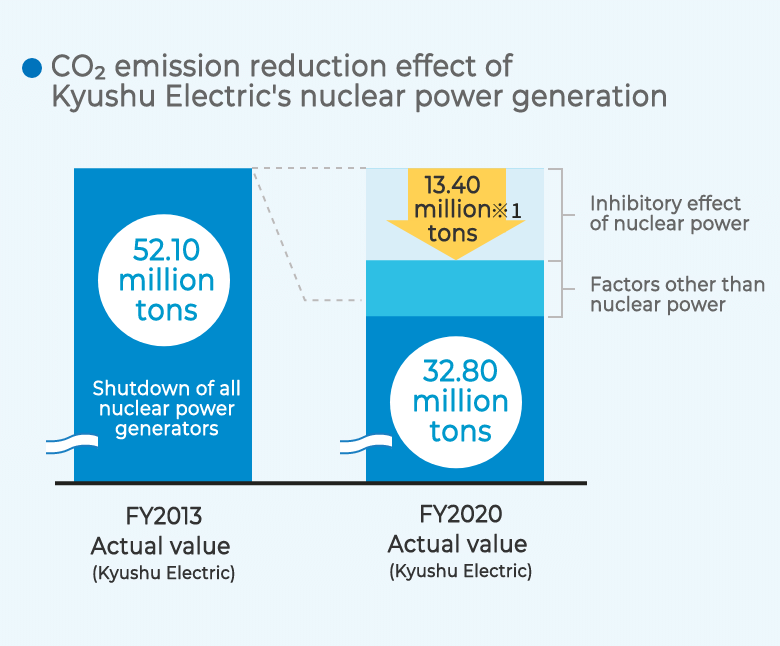
*1 CO2 emission factor (after adjustment)0.617kg-CO2/kWh for FY2013 is used
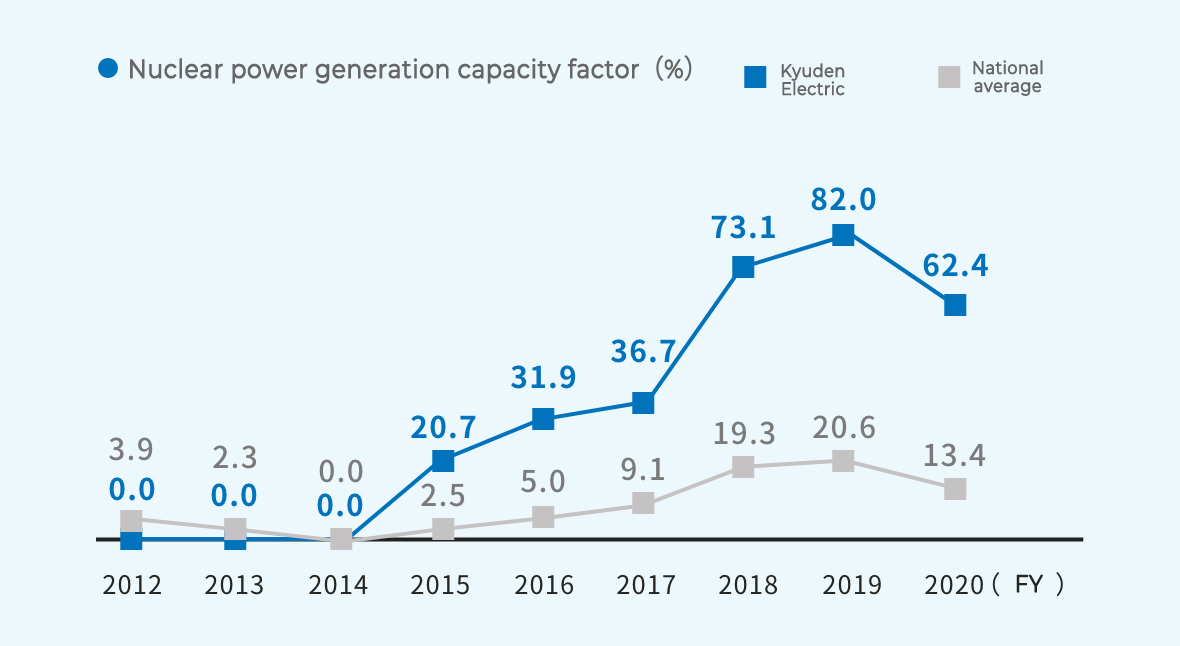

Topics
- The special inspection required for application for extension of the operating period based on the Nuclear Reactor Regulation Law was started on October 18, 2021 for Sendai Nuclear Power Station Unit 1, and will begin in late February 2022 for Unit 2.
- In order to operate a nuclear power station for more than 40 years after the start of operation, it is necessary to apply to the Nuclear Regulation Authority for an operation period extension authorization with the special inspection results attached, and obtain approval.
- A special inspection will be conducted, and the authorization for an operation extension will be determined based on those results.
Net-zero Thermal Emissions
- Continue to further improve the efficiency of thermal power generation.
- We intend to phase out inefficient coal-fired power by 2030, factoring in supply capacity, supply cost, and circumstances of communities where coal-fired plants are located.
- Study the production and co-firing of carbon-free hydrogen and ammonia using surplus electricity from renewable energy sources. In the future, we will aim to increase the co-firing rate and shift to single-fuel firing. In addition, we will study the establishment of a supply chain for hydrogen and ammonia procurement.
- Adopting CCUS*/carbon recycling technologies, as well as using forest carbon sinks and carbon credits.
*Carbon dioxide Capture, Utilization and Storage
Hydrogen/Ammonia production and co-firing
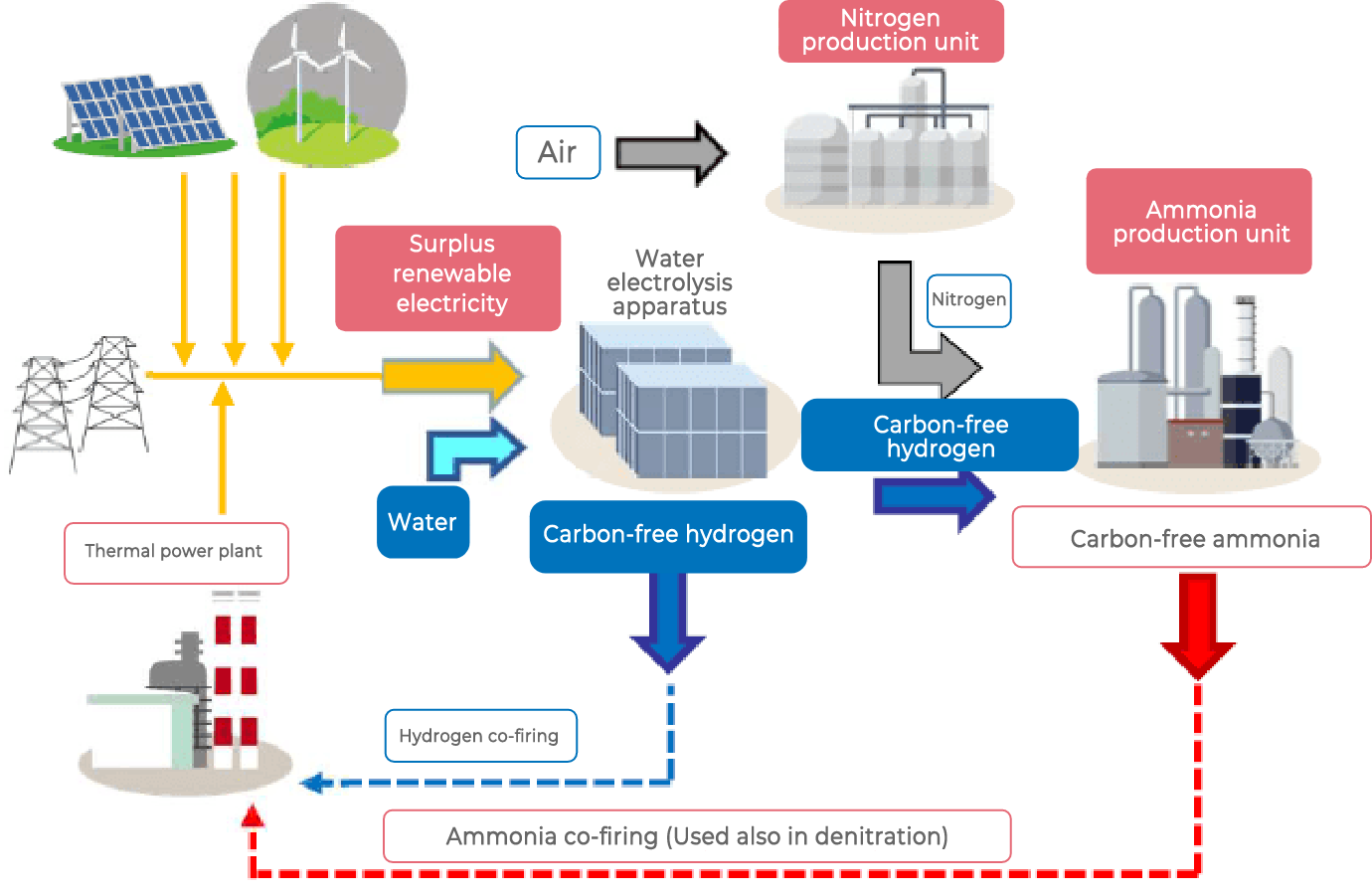
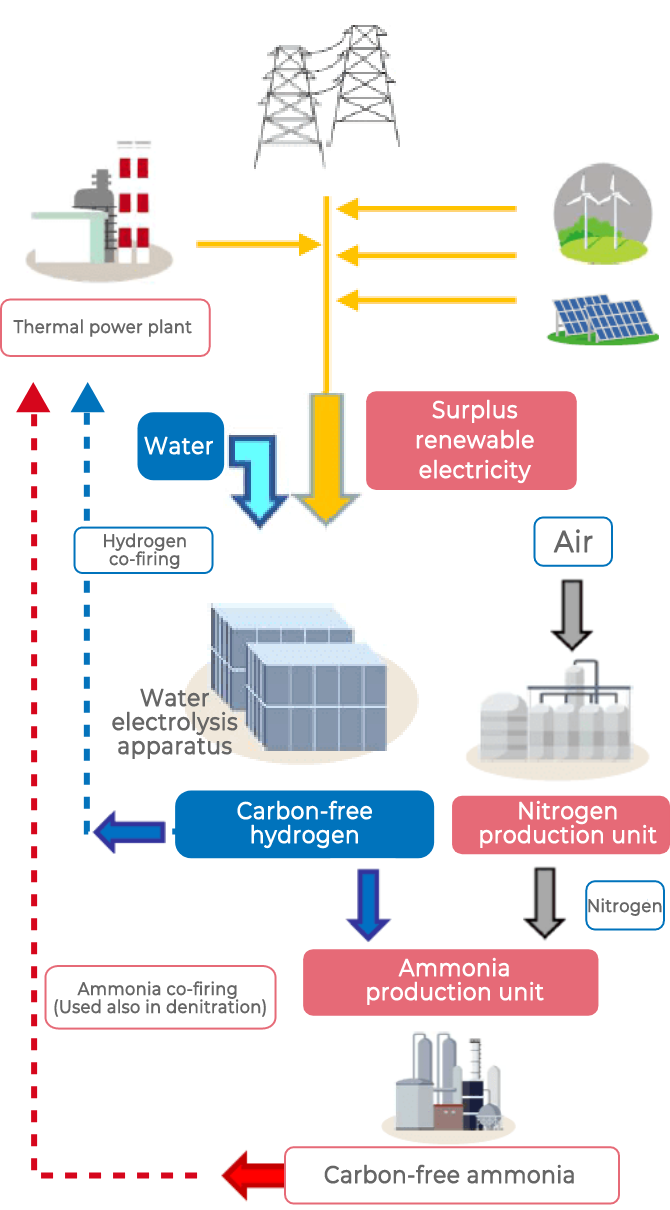
CCUS/Carbon recycling
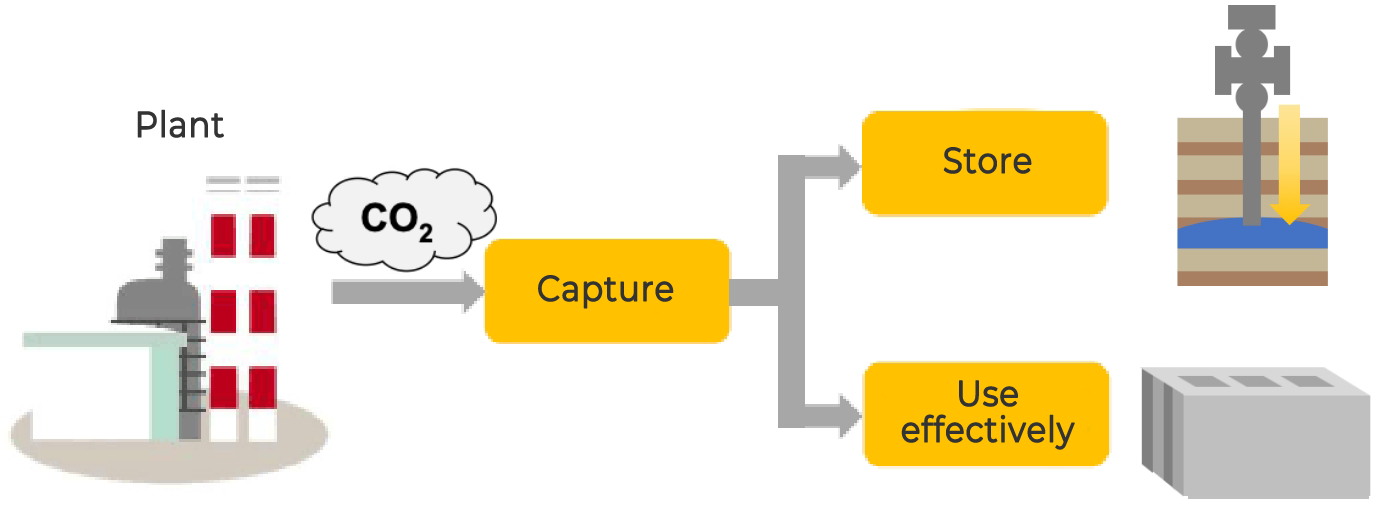

Forest carbon sink (Kyushu Rinsan: Kyuden Group)
Carbon absorption by proper forestry
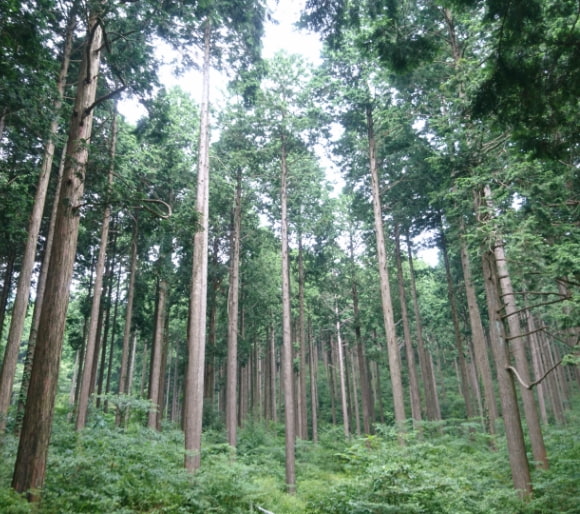
Company-owned forest (Yamashita-ike forest in Oita Prefecture)
- Forest area owned by Kyushu Electric: 4,447ha (630 times the size of PayPay Dome, a baseball field in Fukuoka)
- Number of trees managed (as of late FY2020):5.04 million (Only artificial forests)
- Quantity of carbon fixation (FY2020):1.305 million tons[Contribution to achieving carbon neutrality]
Reducing the carbon intensity of thermal power
- In the case of thermal power generation, in addition to the LNG combined cycle, which offers excellent flexibility as a power source for adjusting to fluctuations in the output of renewable energy sources, our Group has been making a significant contribution to the expansion of renewable energy through the design and operation of coal-fired thermal power plants that can handle intermediate loads.
- We will continue to proactively pursue low-carbon initiatives, such as increasing efficiency, addressing the fade-out of inefficient coal-fired thermal power plants by 2030, utilizing fuels for power generation such as hydrogen and ammonia that do not produce CO2 during combustion, and considering the application of CO2 capture technologies.
Topics
- When controlling the output of solar power and other renewable energy sources, we use pumped-storage power generation, as well as shutting down or maximizing the output of thermal power units, based on the priority dispatch rules set out in the Renewable Energy Special Measures Law.
- If a large number of thermal power stations were to be shut down during the day, there is a risk that they would not be able to increase their output in time to meet demand in the evening, when solar output is almost zero.
- In the daytime hours, our thermal power plants are operated with a minimum output (15%), which is much lower than the grid requirement (50%), and with the DSS (Daily Start Stop) function, which is highly agile and accurate, and contributes greatly to the maximum acceptance of renewable energy and the stable supply of electricity.
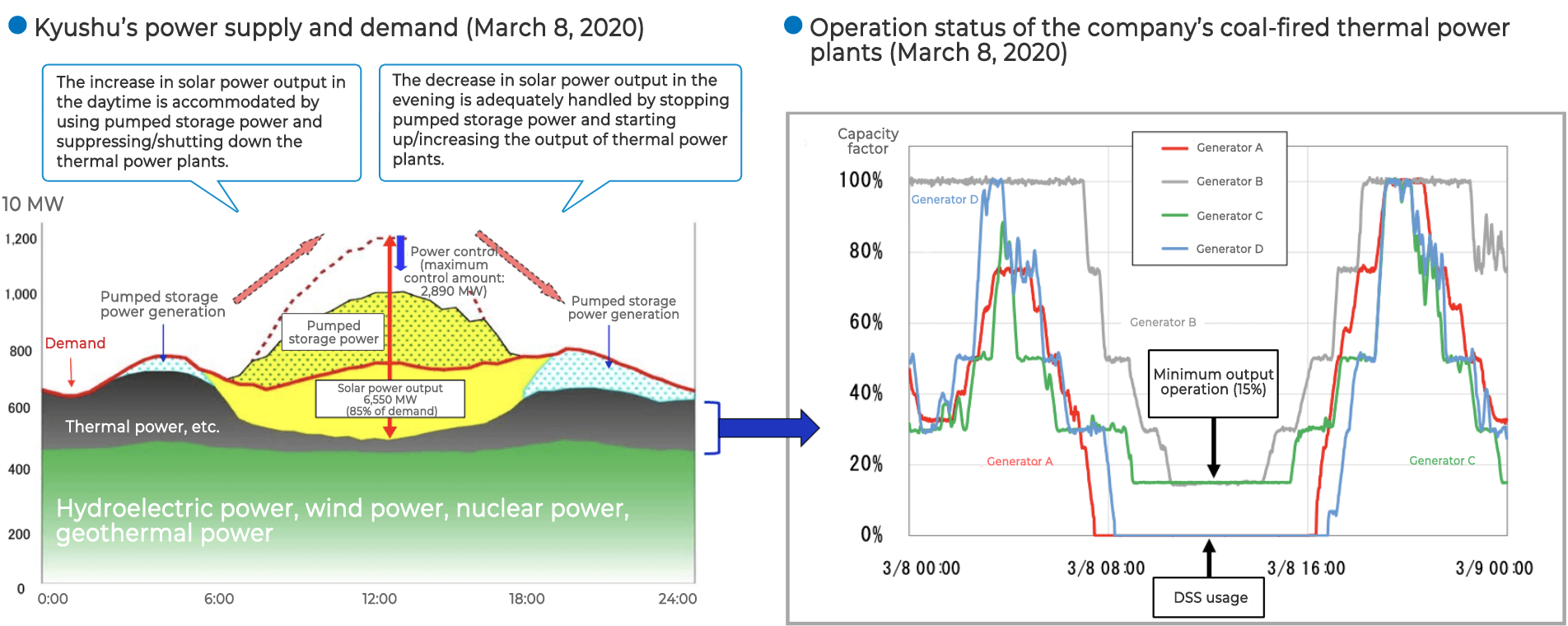
Kyushu's power supply and demand (March 8, 2020)
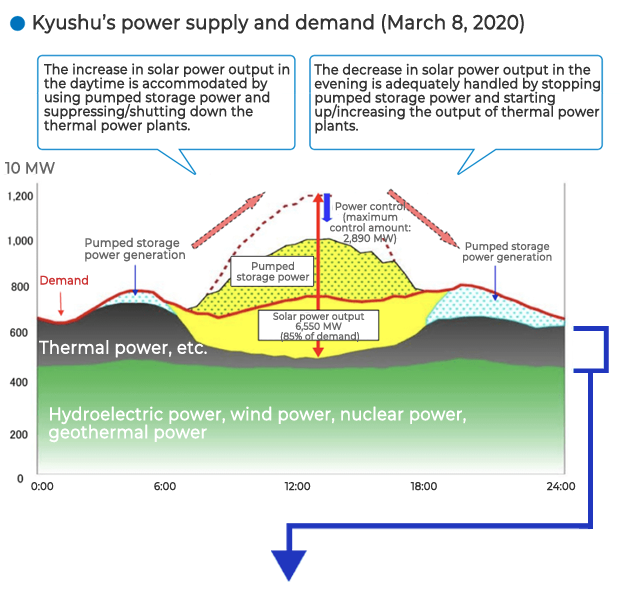
Operation status of the company's coal-fired thermal power plants (March 8, 2020)
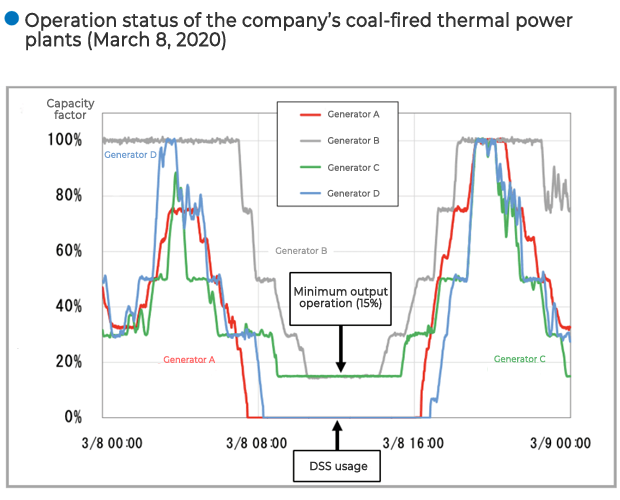
Achievement of benchmark indices (Response to phase-out of inefficient coal-fired thermal power)
- 2030 KPI
- Achievement of Energy Conservation Act benchmark indices(Index A/Index B/Coal-only index)
- We aim to achieve the benchmark index of the Energy Conservation Act in 2030 by operating coal-fired and LNG-combined power plants with high thermal efficiency, including the Matsuura Power Station Unit 2, which started commercial operation in December 2019, and by utilizing carbon-free fuels.
- With regard to inefficient coal-fired thermal power plants, we aim to fade them out by 2030, taking into account the national energy policy, but also taking into account the stable supply of electricity, energy costs and the circumstances of the region where they are located.
Change in benchmark indices
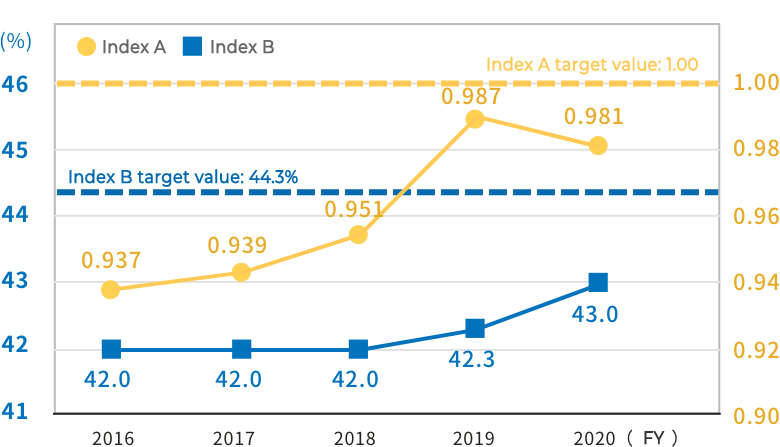
The coal-only index is subject to the Energy Conservation Act report from 2023.
List of Kyuden's coal-fired thermal power plants (end of February, 2022)
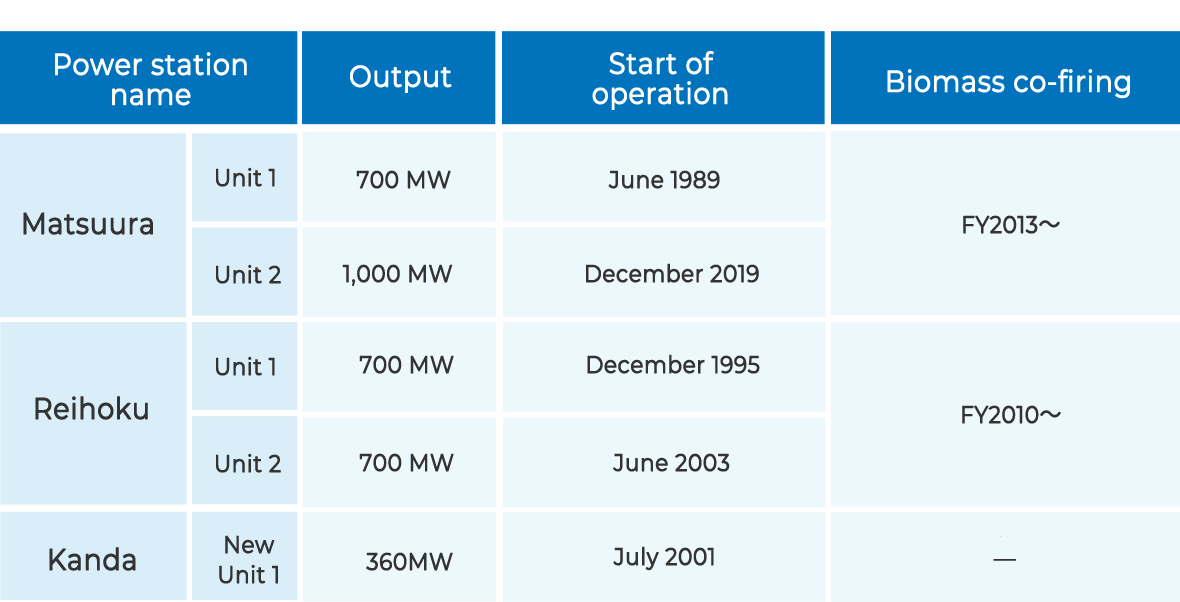
Topics
- We are currently considering the development of an LNG-fueled power plant in Kitakyushu City, Fukuoka Prefecture, in collaboration with Saibu Gas.
- The power generation method will use a cutting-edge combined cycle system, which is expected to reduce CO2 emissions by more than 20% compared to combined cycle systems that fist came out in the 1990s, and we also consider the use of carbon-free fuel (ammonia/hydrogen) in the future.
Considered operation of a new LNG combined cycle power station
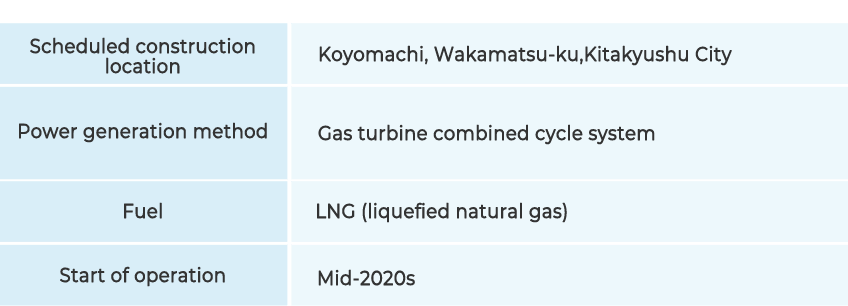
Establish technology for co-firing of carbon-free fuel
- 2030 KPI
- Establish technology for co-firing of 1% hydrogen and 20% ammonia
- With regard to the co-firing of hydrogen and ammonia in thermal power generation in relation to the development of new high-efficiency thermal power plants, we will keep a close eye on the innovation of "quantity, price, and supply chain", which is considered to be important for the implementation in society, and contribute to the carbon neutrality of the power supply side as much as possible while pursuing the compatibility with economic rationality.
- Specifically, we are working towards a technology for co-firing 1% hydrogen and 20% ammonia by 2030 so that electricity can be generated when carbon-free fuels are used in large quantities.
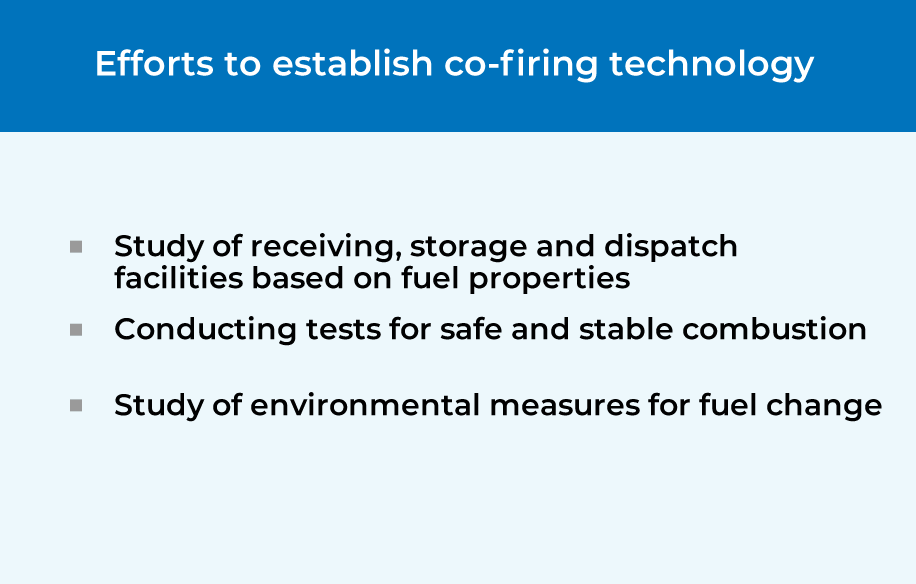
Co-firing of hydrogen/ammonia
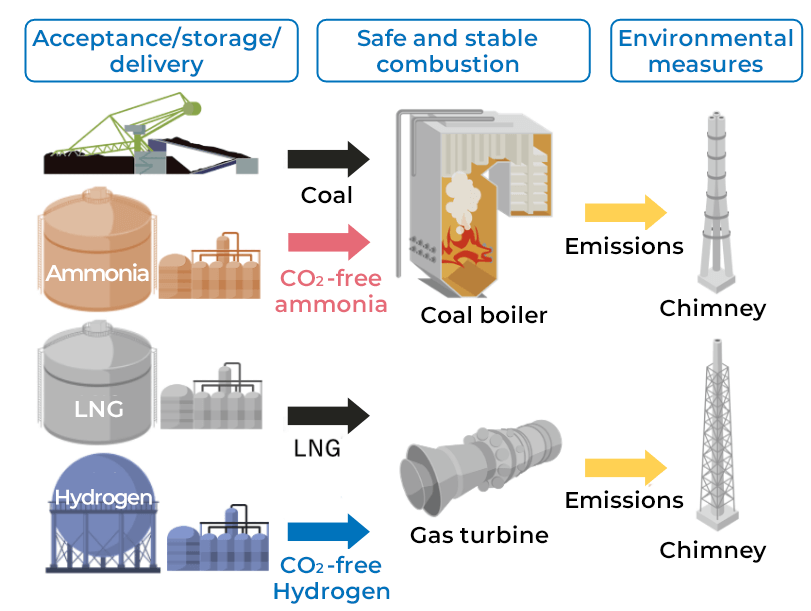
Topics
- On 27 September 2021, we signed a memorandum of understanding (MOU) with Yara International, one of the world's largest manufacturers of nitrogenous fertilizers, to discuss collaboration in the production of clean ammonia (blue ammonia and green ammonia).
[What we are considering in detail]
- Establish a supply chain from production of clean ammonia to its use in power plants
- Establishing a system for receiving and shipping clean ammonia for a wide range of uses around Kyushu
Supply chain of hydrogen/ammonia
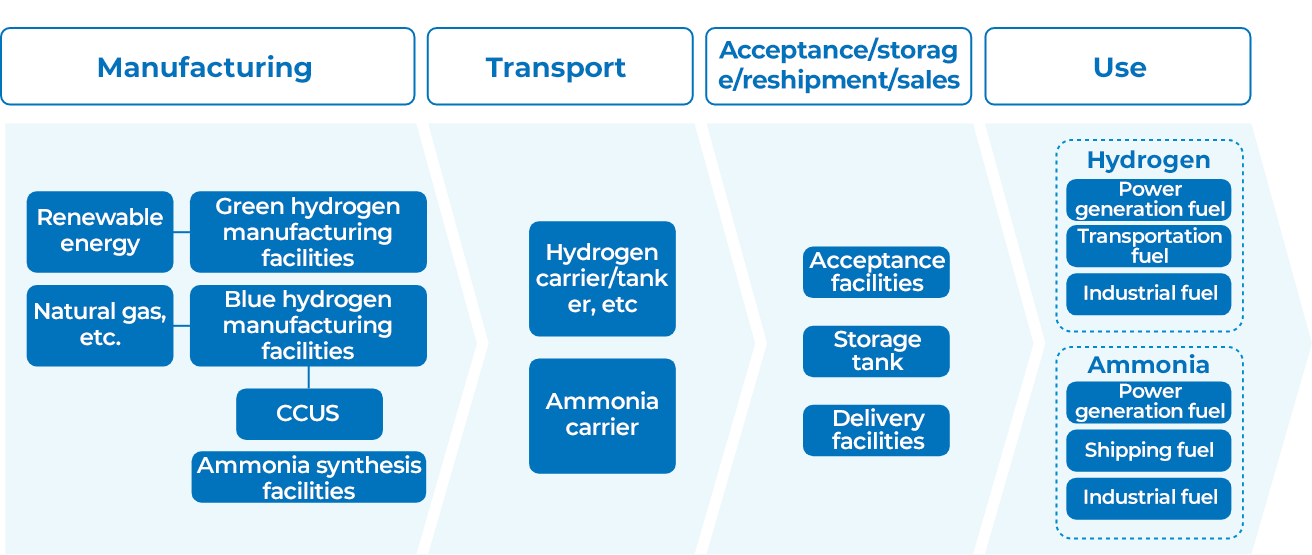
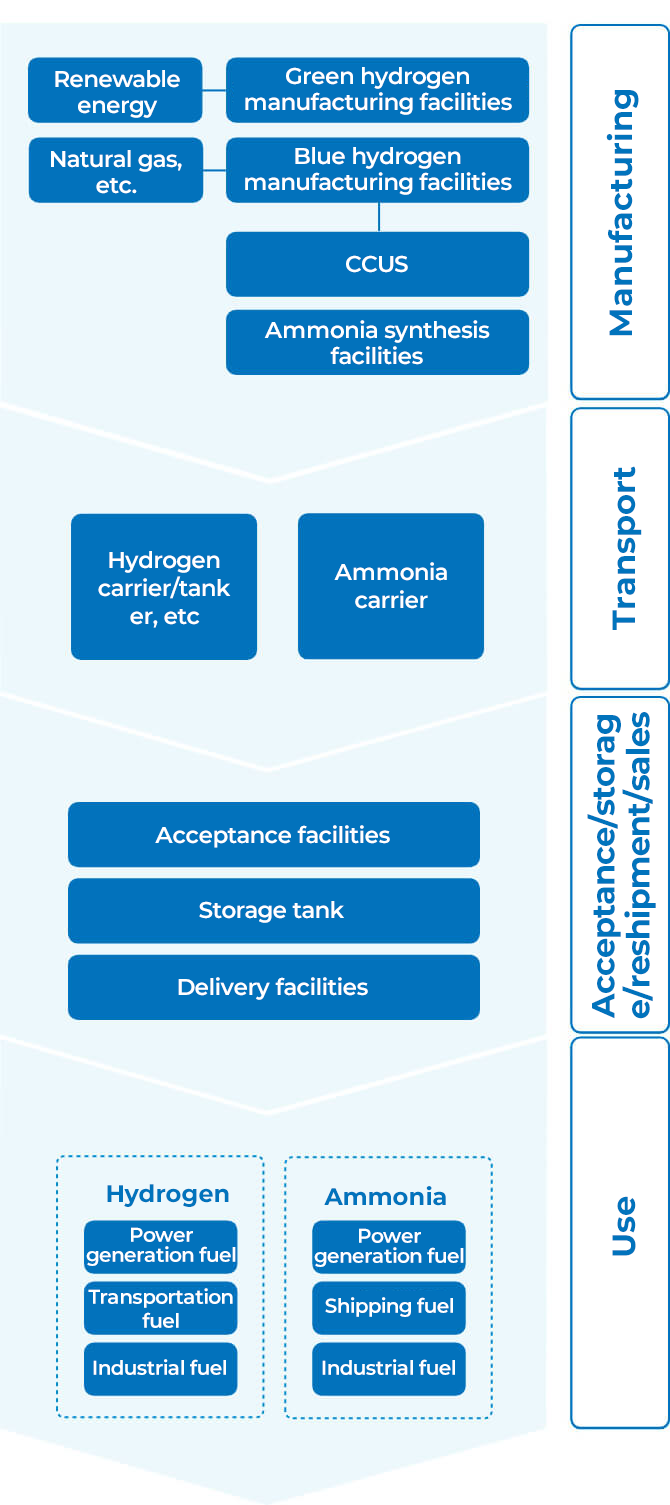
- We will study hydrogen production, transportation, storage and utilization of hydrogen by water electrolysis equipment, etc., utilizing the Kyuden Group's abundant zero-emission power sources. We will accelerate our efforts for social implementation.
- Specifically, we will consider demonstrations in "decentralized areas (inland areas, etc.)" and "areas of industrial concentration (factories, industrial complexes, ports, etc.)", as well as collaboration between the two areas.
Considerations for social implementation of hydrogen
